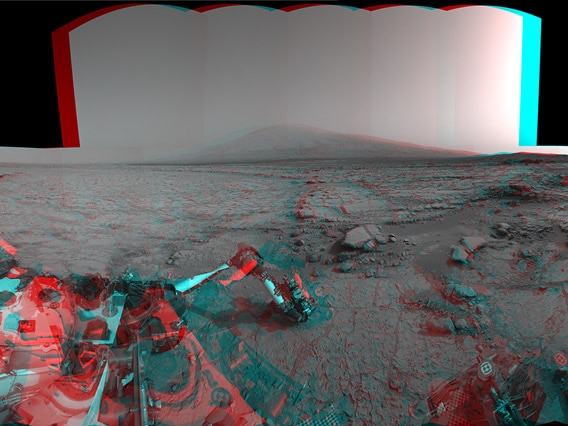Create a free profile to get unlimited access to exclusive videos, sweepstakes, and more!
Curiosity Rover Takes a Sharp 3D Picture of Mars

Because why not: Hereâs a very cool 3D picture from the Mars rover Curiosity, showing the nearby landscape and the distant peak of Mt. Sharp:
I love these kinds of images! You need red-green (or, more accurately, red-cyan) glasses to see them, of course. I know some folks have them; if you donât you can make them yourself easily out of inexpensive craft materials, or you can find them online for a buck or two. I recommend it; there are tons of these kinds of images (called anaglyphs) online. And not just ones of Mars, but also space shots, astronomy pictures, and more.
Curiosity is equipped with several instruments, including a navigational camera (called, oddly, Navcam), which is actually two cameras, one on the left and another on the right. These provide slightly different perspectives, and can be combined to create anaglyphs like the one above. They trick your brain into thinking youâre seeing in actual three dimensions by showing you one view in one eye, and the other slightly different view in the other eye. Your brain is actually pretty easy to fool. But this is more than a trick: The combined images do provide distances to various nearby objects, which can be used to help navigate the rover around obstacles, or to interesting targets.
Curiosity landed on Mars in August 2012, touching down in Gale Crater, a 154-kilometer-wide (96 mile) impact crater. Like most big craters, thereâs a large central peak, a mountain in the middle. The official name of the peak is Aeolis Mons, but everyone informally called it Mt. Sharp (though, to be honest, the Greek name is way cooler). Curiosity is making its way toward the mountain, examining the ground around it as it goes.
In the anaglyph, Sharp stands out like a colossus in the distance. For me, though, the scene-stealer is the shelf of sedimentary rock stretching off to the horizon. Gale Crater, apparently, was once a lake, very long ago. Some event or series of events dried Mars up, and now, a billion or so years later, well, there it is. Dry, perhaps dead, but still brimming with evidence of its wet past.
Curiosityâs mission is not even halfway to its goal yet, and, obviously, there is much, much more to see and explore.


























